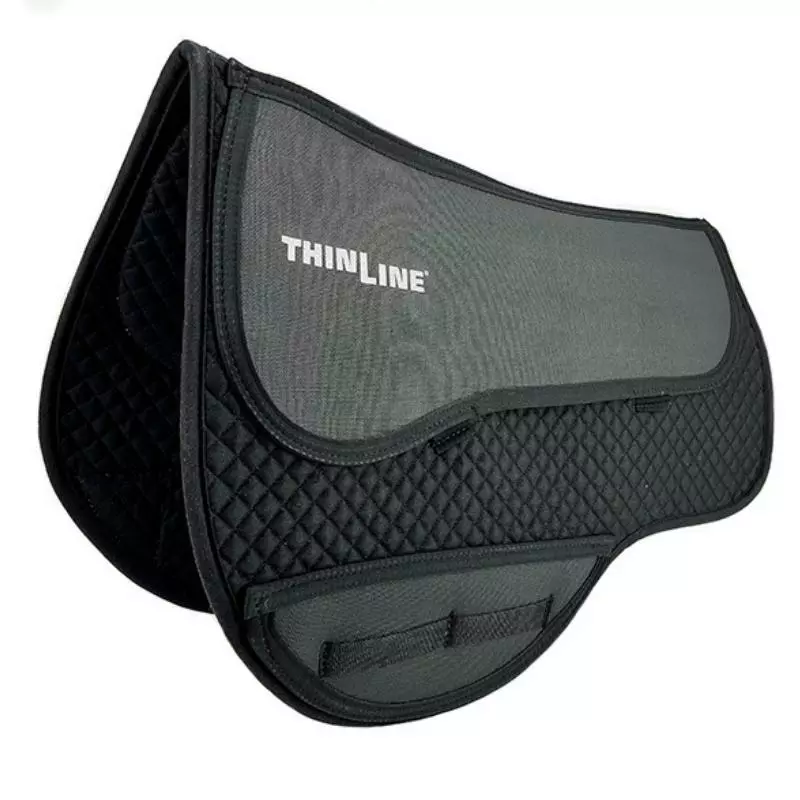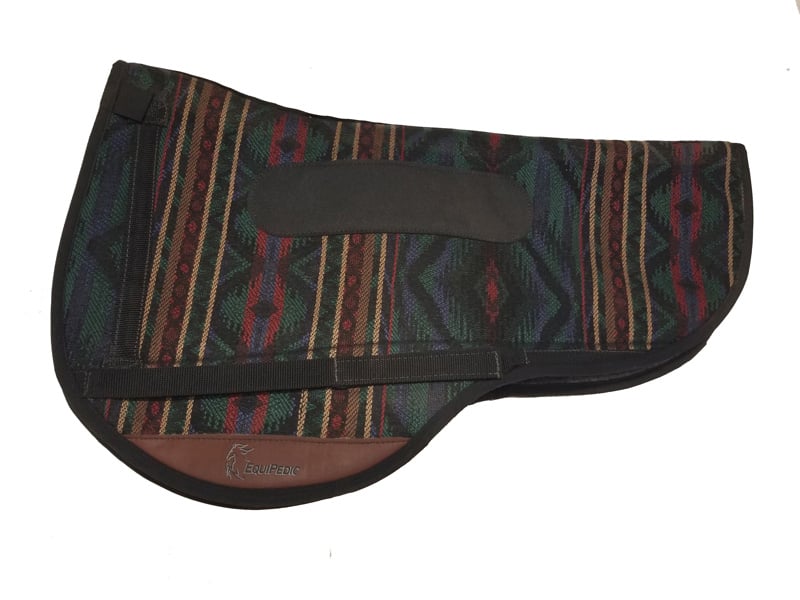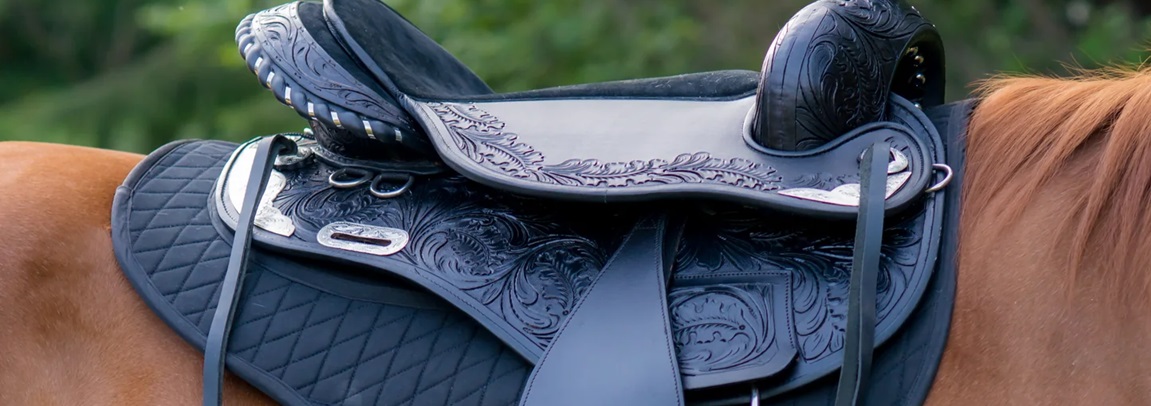Choosing the best treeless saddle pad requires understanding how treeless saddles differ from saddles with a tree.
For comparison, a saddle with a tree, or treed saddle, is constructed with a rigid “tree” made of wood, carbon, or synthetic material.
The tree sits on the horse’s back, straddling the spine, and distributes the rider’s weight over the horse’s back.
A treeless saddle doesn’t have a tree.
The lack of that rigid structure makes it flexible, so it moves and bends with the horse, similar to a bareback pad.
This flexibility makes treeless saddles instantly adaptable to changes in the horse’s body, promotes freer movement, and gives the rider a close feel. However, some riders feel less secure in this type of saddle.
The rider’s weight is less evenly distributed in a treeless saddle. The horse might also have conformation problems that make fitting a treeless saddle challenging, for example, prominent withers or sway back.
For these reasons, saddle pad selection for a treeless saddle becomes more than just a supporting element—as the correct pad can promote horse health, comfort, and rider security.

Example of a treeless saddle
At ThinLine, the core of our saddle pad design philosophy has always been to prioritize horse and rider protection and comfort.
The carrying capacity of ThinLine material—essentially acting as a suspension bridge—offers an even higher level of support when riding in a treeless saddle vs. a treed saddle.
ThinLine pads are often recommended by professional treeless saddle fitters for comfort and compatibility.
Review of Popular Treeless Saddle Pad Brands
A well-selected saddle pad can significantly improve the riding experience in a treeless saddle. It can offer relief to the horse’s spine, decrease saddle slippage, and help evenly distribute the rider’s weight across the horse’s back.
Below, we’ll review four more popular treeless saddle pad brands.
1. ThinLine
As the only saddle pad endorsed by back surgeons, master saddlers, and veterinarians, ThinLine saddle pads and half pads are prominent for their extraordinary shock absorption, weight-carrying capacity, longevity, and thoughtful designs.
Their benefits as treeless saddle pads include:
- Shock-absorbing material serves as a suspension bridge and carries the rider’s weight evenly – providing support and stability
- The thinnest foam material on the market buffers shock for both horse and rider while preserving closeness with the horse
- Breathable for cooling, anti-fungal and anti-bacterial
- Shim pockets available for fitting adjustments
Thinline pads, known for their superior quality and design, are particularly effective with treeless saddles. These pads ensure the horse’s comfort and the saddle’s stability aren’t compromised, making them indispensable for riders who prefer treeless saddles.

2. Skito
Skito’s website states that 95% of their treeless pad sales are custom orders, a popular but more expensive option. These pads also:
- Are available in multiple fabrics and prints
- Come in a variety of wool and wool blends
- Offer different accessories to prevent slippage
- Are machine washable (except foam inserts), air dry
Skito pads receive good reviews because they’re customizable and adaptable.
3. HAF
HAF pads provide stability and are breathable, durable, lightweight, and easy to clean. HAF pads feature Sympanova padding, which
- It doesn’t absorb sweat
- It contains nodules that massage the horse’s back
- Provides grip to eliminate slippage
These pads also feature a Velcro panel system for foam inserts, creating extra height for wither clearance.
4. EquiPedic
EquiPedic pads contain technological components that increase blood flow, reduce overheating, and conform to the horse’s body. They also
- Eliminate pressure points
- Are anti-fungal, anti-bacterial, and 100% breathable
- Are anti-slip and machine washable
Ultimately, it comes down to the horse’s needs, rider preferences, and budget when selecting a pad for a treeless saddle.
What’s most important is choosing the brand that best corrects saddle fit problems and enhances your riding and your horse’s comfort.

Fitting Your Treeless Saddle Pad
Achieving the perfect fit with a treeless saddle pad involves several key steps. Start by measuring your horse’s back to select a pad that matches its size and shape. When positioning the pad, ensure it sits evenly on the horse’s back, allowing for ample withers clearance.
Adjustments might be necessary to accommodate specific anatomical features or correct any saddle position imbalance.
Common Fitting Challenges
Saddle slippage and uneven pressure distribution can affect the horse’s comfort and performance.
Solutions include using non-slip materials beneath the pad and strategic shimming to address unevenness or to adapt to the horse’s changing physique.
Popular Questions
Below you can see some of the common questions were asked about this topic.
Can treeless saddle pads be used effectively with traditional treed saddles, or are they exclusively used for treeless saddles?
Saddle pads designed explicitly for treeless saddles can address unique challenges, such as spine protection and weight distribution enhancement. That being said, such pads can also serve a purpose with traditional treed saddles, augmenting comfort and improving fit.
What maintenance and care routines are recommended for extending the life of treeless saddle pads?
Consistent cleaning and routine checks for any signs of damage are necessary to prolong the lifespan of your treeless saddle pads. Always use cleaning products recommended by the manufacturer. Make sure to air dry the saddle pads once they are cleaned thoroughly. Store them in a cool, dry place to avoid degradation.
Are there any specific considerations for using treeless saddle pads in hot or cold climates to ensure horse comfort?
Using treeless saddle pads in extremely hot or cold climates necessitates special thermal regulation and moisture control considerations to maintain the horse’s comfort. Selecting materials that offer both insulation for low temperatures and breathability for warmer weather is pivotal.
How do materials used in treeless saddle pads (e.g., wool, foam, Ggel) impact the horse’s performance and comfort during long rides?
They influence heat dissipation and shock absorption and distribute the rider’s weight evenly, affecting the horse’s well-being and efficacy.
Final Points
Picking the perfect pad for a treeless saddle requires meticulous evaluation of factors like material, design, and how well it fits the horse’s back. The ideal pick relieves the spine, distributes weight evenly, and ensures stability, improving the riding experience and promoting the horse’s health.
Quality brands such as Thinline, Skito, HAF, and Equipedic pads have demonstrated their ability to meet these demands.
However, ThinLine is the only brand endorsed by master saddle fitters, veterinarians, and spine surgeons.
ThinLine pads are ideal for use with treeless saddles because
- Their shock-absorbency reduces concussion for both horse and rider
- Their thin construction protects the feeling of closeness with the horse – one of the reasons riders choose a treeless saddle
- They distribute weight evenly, thereby eliminating pressure points while offering stability and security
- They’re shimmable so that riders can address problems with fit
- They’re breathable, non-slip, anti-fungal, and anti-bacterial
ThinLine pads won’t interfere with the closeness and freedom a treeless saddle provides.

